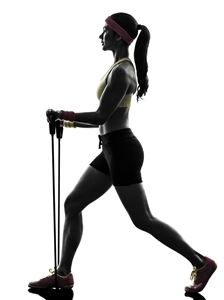Although a resistance band only weighs a few ounces, it can be extremely useful on travel physical therapy assignments. Portable and cheap, resistance bands are ideal rehabilitation equipment for patients who want to recover quickly, strengthen their muscles and take it easy on the joints.
Unlike dumbbells and other physical therapy workout equipment, resistance bands are easy to transport, so patients can bring them anywhere. As travel therapy professionals know, consistency is key to a successful rehabilitation. With more hands-on training and access to their healing equipment, your patients can recover more quickly and efficiently.
They're also great for travel PT professionals who are often on the move. While dumbbells provide weight training, resistance bands create constant tension throughout a movement, recruiting more muscle fibers that in turn, accelerates growth. The biggest uses of the bands include:
- Balance training, especially for older patients
- Stretching exercises for muscle length impairments
- Cardio training for cardio-respiratory problems
- Functional and sport-specific training for functional limitations
Rehab exercises
Here are a few exercises for common injuries that incorporate resistance bands:
Front squat: The lower back is a constant source of pain for people across the country. To help remedy a patient's bad back, tell him or her about the front squat exercise. Have them stand on a tube band with their feet slightly wider than their shoulder, with the center of the band between their feet. Gripping a handle in each hand, lift the band over each shoulder while in a squatting position. Remind them to keep their abs firm, chest up and press their knees over their toes. Have them return to the start position and repeat for eight to 12 reps.
Ankle flexion: Ankles are another major problem point. They may get stiff after running or feel wobbly while playing lateral-movement sports like tennis and football. To work out the ankles with the bands, secure a loop or therapy band around an anchor such as the leg of a coffee table or chair. Have the patients lay down on flat surface and wrap the other loop around the front of their foot. While supporting themselves with their hands, they will slowly tilt the front of their foot toward the anchoring object, then lift it back up until they feel a good stretch in the shins. Instruct the patient to complete 10 to 12 reps on each ankle.
Overhead press: Assign patients with shoulder issues the lateral raise using a resistance band as you see fit. The exercise starts with the individual standing on the resistance band with feet shoulder-width apart. With palms facing forward, instruct patients to grip the band handles and lift them above their shoulder with elbows bent at about 90 degrees. They will extend their arms up overhead, bringing their hands together at the top. Then they will slowly lower their hands, and repeat for eight to 10 reps.

